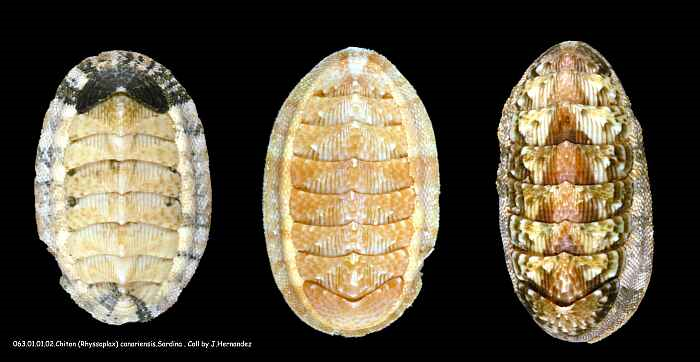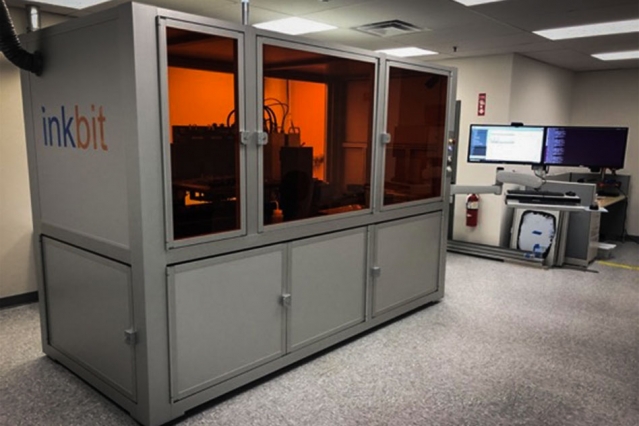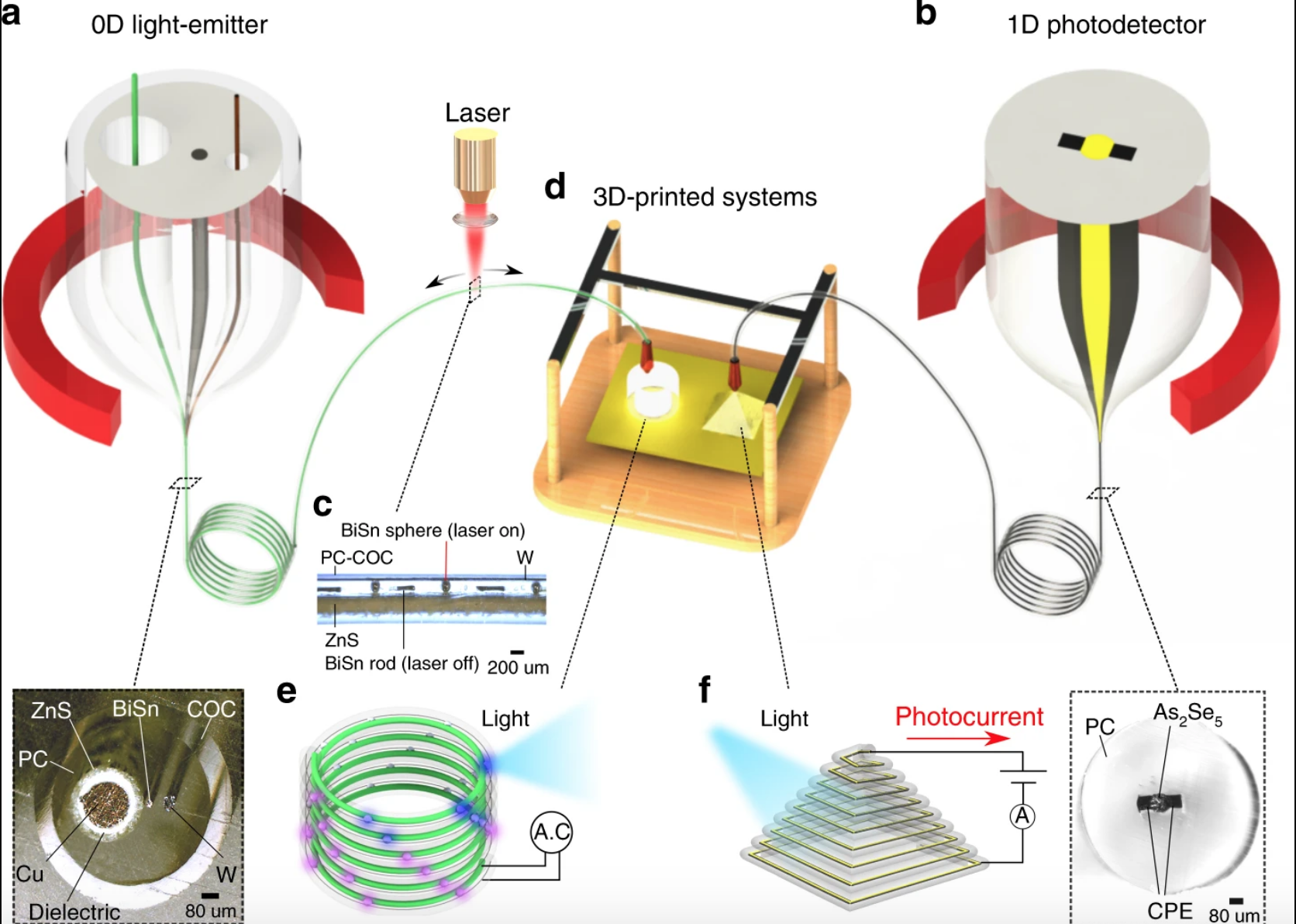MIT engineers use conducting polymers to 3D print soft and flexible brain implants
Engineers 3D Print Soft, Rubbery Brain Implants
via MIT
The brain is one of our most vulnerable organs, as soft as the softest tofu. Brain implants, on the other hand, are typically made from metal and other rigid materials that over time can cause inflammation and the buildup of scar tissue.
MIT engineers are working on developing soft, flexible neural implants that can gently conform to the brain’s contours and monitor activity over longer periods, without aggravating surrounding tissue. Such flexible electronics could be softer alternatives to existing metal-based electrodes designed to monitor brain activity, and may also be useful in brain implants that stimulate neural regions to ease symptoms of epilepsy, Parkinson’s disease, and severe depression.
BMF announces global launch of microArch 3D printers, appoints ex-UItimaker president to CEO
Researchers develop flexible 3D printed armor inspired by mollusks
Collaborative Research Team Creates 3D Printed Armor Inspired by Chiton Scales
From lobster claws and fish scales to conch shells, humans have often been inspired by nature in the creation of protective gear. Recently, a team of researchers hailing from MIT, Virginia Tech, Harvard University, California State University Fullerton, and the Max Planck Institute of Colloids & Interfaces published a paper, titled “Bioinspired design of flexible armor based on chiton scales,” about their work using multimaterial 3D printing and parametric computational modeling to create “a synthetic flexible scaled armor analogue” based on the scaled armors of chitons, a group of marine mollusks.
“This approach allows us to conduct a quantitative evaluation of our chiton-inspired armor to assess its orientation-dependent flexibility and protection capabilities,” the researchers wrote in the abstract.
Biological armor offers mechanical protection from the environment, which includes attacks from predators. Man-made armors use rigid structures for this protection, which the team explained can result “in a trade-off with flexibility and maneuverability.”
“Many chiton species possess hundreds of small, mineralized scales arrayed on the soft girdle that surrounds their overlapping shell plates,” the abstract states. “Ensuring both flexibility for locomotion and protection of the underlying soft body, the scaled girdle is an excellent model for multifunctional armor design.”
Because many biological armors are based on hard and rigid armor plates, flexibility is tough to pair with it. Scale-like armors with many small, repeating elements, like that of chiton, can help maximize the combination of flexibility and protection. The team completed a study of the 3D geometry, interspecific structural diversity, material composition, and nanomechanical properties of chiton girdle scales, focusing on the chiton Rhyssoplax canariensis (Chitonidae: Chitoninae). This species is covered by a total of eight “bilaterally symmetrical overlapping mineralized shell plates,” in addition to the protective scaled girdle.
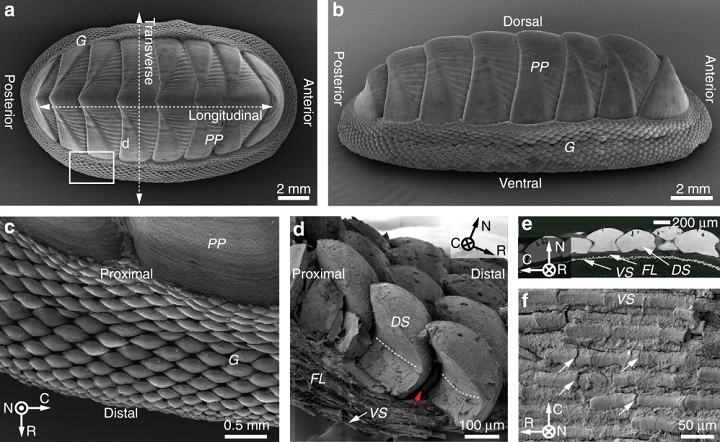
Figure 1. Biological flexible scaled armor in the girdle of the chiton Rhyssoplax canariensis. a, b Wide-field SEM images of the chiton R. canariensis, which show the dorsal and side view of the primary plates (PP) and peripheral scale-covered girdle (G), respectively. c Enlarged view of the girdle covered with dorsal scales. The image was acquired from the region indicated by the rectangular box in a, highlighting individual overlapping dorsal girdle scales, a fully covered protective armor. d Fractured cross-section of the girdle scaled armor, which consists of three components arranged from dorsal to ventral: (1) dorsal scales (DS); (2) fibrous layer (FL); and (3) ventral scales (VS). The white dashed lines indicate the height of the inter-scale organic matrix, and the red arrow indicates gaps between adjacent scales. e Cross-sectional view of scaled armor based on micro-computed tomography (μ-CT) data. Note the distance between the dorsal and ventral scale layers, which is occupied by the fibrous layer. f SEM image of the rod-shaped ventral scales, where the white arrows indicate small cracks.
“In contrast to most shelled mollusks where mobility is limited, as in the single shelled mollusks (gastropods, including snails, scaphopods or tusk shells, and some cephalopods such as Nautilus) or hinge-shelled bivalves (mussels, clams, scallops, etc.), most polyplacophorans (chitons) are characterized by eight overlapping, hard shell plates (Fig. 1a, b), which collectively accommodate a wide range of motion,” the researchers explained. “In addition to the eight overlapping shell plates (which are functionally analogous to the segmented plate-like exoskeleton of many crustaceans), additional protection is provided by a thick leathery girdle that skirts the animal’s periphery.”
Even though the girdle scales are nearly pure mineral and very rigid, they are also very flexible and able to conform to rough surfaces. Chiton scales are also more uniform in composition, with no porosity, sub-layering, or material heterogeneity.
“This observation underlines the suitability of chiton scales as a model for bioinspiration, as the mechanical performance of their armor can be ascribed primarily to geometric considerations, rather than fine scale material variation,” the team noted.
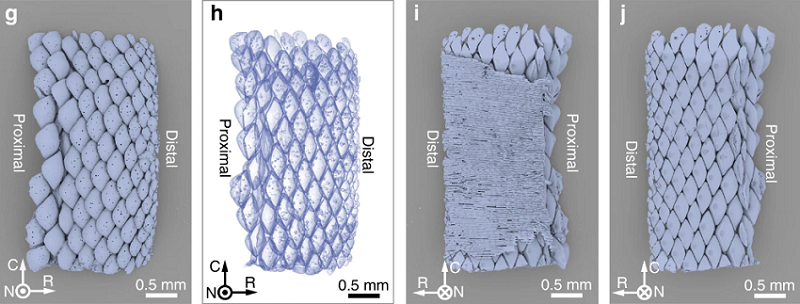
Figure 1. g–i: μ-CT 3D rendering of the chiton R. canariensis girdles in different viewing orientations and modes: g top view of girdle scales, h transparency mode showing the overlapping characteristics among adjacent scales, bottom view i with and j without ventral scales. Local coordinates: N (normal), from ventral to dorsal; R (radial), from proximal to distal; C (circumferential).
The team used many experimental and modeling approaches, such as mechanical testing, finite element modeling, electron microscopy, synchrotron X-ray micro-computed tomography, and instrumented nanoindentation, to investigate chitons, and the use of chiton-like scales in 3D printed flexible armor.
“Incorporating the physical and functional properties of chiton girdle scales characterized in these investigations, we design a bio-inspired flexible armor system, integrating parametric geometrical modeling and multi-material 3D printing,” the researchers wrote. “We explore the functional trade-offs between protection and flexibility in this model scaled armor system and its potential for informing the design of additional functional prototypes.”
A Connex 500 multi-material 3D printer from Stratasys was used to create prototypes out of both flexible and rigid photopolymers in different colors.

3D geometry and surface morphology of individual dorsal scales of the chiton R. canariensis. a–f: μ-CT data-based 3D rendering of individual girdle scales in different view angles and modes: a front view, b top view (yellow arrows indicate pore openings), c bottom view (white arrow shows a depression at the base of the scale), d two side-views (white arrows shows the surface roughness at the lower surface of backside), e back view, and f transparent mode (the yellow arrows show holes in the dorsal surface of scales and the white arrow indicates depression in base). g Projection contours along two orientations (transverse and bottom) are used to describe the geometries of chiton scales. h Top view of a μ-CT data-based reconstruction of the girdle scale assembly of R. canariensis. Three columns of scales used in the geometrical measurement are highlighted in pink color and their positions are indicated. i Variations of geometrical parameters as a function of scale position. The solid line represents the average and the shaded area shows the standard deviation. j SEM image of a scale’s back surface. k Magnified-view of scale surface with microscopic bumps at the underside of the back surfaces of chiton scales, as indicated by the white box in j. l SEM-derived stereographic reconstruction of microscopic bumps in a similar region shown in k. m Backscattered SEM image of a polished cross-section in the region of microscopic bumps of a scale, highlighting the difference in morphology between the front and back surfaces of the dorsal scales.
“In order to successfully mimic scale morphology for the production of a 3D-printed structural analogue…quantitative measurements of the scale geometry were conducted by defining several morphometric parameters,” the researchers stated.
The team also took “3D morphometric measurements” of the dorsal girdle scales from chiton species in the Ischnochitonidae and Chitonidae families. In order to reproduce the morphometrics for further modeling of scaled arrays, they created a parametric geometrical model.
“The successful 3D modeling of individual scales allowed us to design a composite scale armor assembly similar to that of chitons,” the team explained. “The bio-inspired armor system included rigid scales embedded in an underlying soft substrate.”
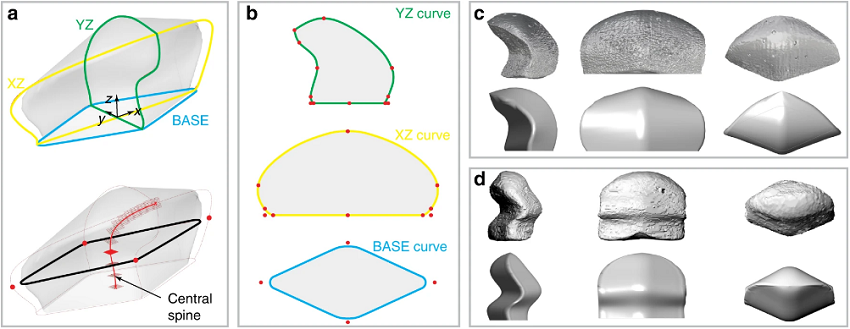
Figure 5. 3D parametric modeling of chiton scale geometries. a Top, the 3D scale model with three principal scaffolding curves. Bottom, 3D scale model highlighted with the central spine for generating the surface meshes. b Three principal curves with geometrical landmarks indicated. c, d Comparison of original chiton scales with corresponding mimicked scale models for two species: c, a single-curved scale from Rhyssoplax canariensis and d, a double-curved scale from Lepidozona mertensii.
They used materials with moduli of ca. 2 GPa and ca. 0.7 MPa, respectively, to 3D print the scales and matrix, in order to properly replicate how the scales would interact with soft girdle tissue. The scale assembly was very flexible, with a similar range of motion to real chiton scales, and the team was able to efficiently explore a variety of arrangements with the scales due to the “parametric nature of our model.”
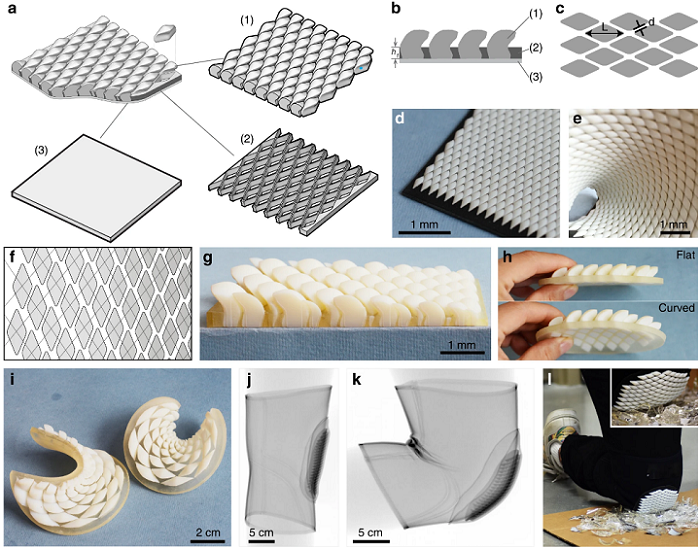
Design and fabrication of bio-inspired flexible scaled armor. a Schematic diagram showing basic components of the armor; (1) scales, (2) matrix, and (3) soft underlying layer. b Side and c bottom view of the armor. d, inter-scale spacing. d Flat panel with uniform scales fabricated through additive manufacturing. e A bent panel showing excellent flexibility. f, g Design of scale pattern with size gradients. h Scale assembly in flat and curved substrate. i Scale assembly on double-curved surfaces. j X-ray projection images of a kneepad based on the bio-inspired scaled protective panel in j extended and k bent positions, demonstrating its conformability and flexibility. l Demonstration of the protection capability of the chiton scale-inspired kneepad on broken glass.
They also studied the mechanical performance of their multimaterial 3D printed prototypes, and even 3D printed a scaled kneepad prototype in order to demonstrate the usefulness of the chiton-inspired system for both protective and flexible applications.
“Current kneepad designs often fall in one of two extremes: hard and rigid plates that create heavy protection but limit flexibility, or elastomeric rubbers/foams that provide high flexibility but limited protection (especially against sharp objects). The chiton scale-inspired knee protection pad offers a unique solution to this dilemma,” the researchers noted.
The 3D printed scale assemblies had much higher puncture resistance than typical kneepads with rubber- or foam-based inserts, and also featured good shape-conforming capabilities in extended and bent configurations.
Co-authors of the paper are Matthew Connors, Ting Yang, Ahmed Hosny, Zhifei Deng, Fatemeh Yazdandoost, Hajar Massaadi, Douglas Eernisse, Reza Mirzaeifar, Mason N. Dean, James C. Weaver, Christine Ortiz, and Ling Li.
Discuss this and other 3D printing topics at 3DPrintBoard.com or share your thoughts below.
The post Collaborative Research Team Creates 3D Printed Armor Inspired by Chiton Scales appeared first on 3DPrint.com | The Voice of 3D Printing / Additive Manufacturing.
Stratasys & DSM Venturing Lead $12 Million Round in Support of Inkbit
Stratasys and DSM Venturing (venture capital arm of Royal DSM) lead the way in yet more financing for startups, acting as the major sources of funding support of $12 million total, in an equity round for Inkbit—the 2017 spinout of the Computer Science and Artificial Intelligence Laboratory (CSAIL) at MIT. Headquartered in Medford, MA, Inkbit’s technology is based on research led by Professor Wojciech Matusik which has evolved into a vision-based, AI additive manufacturing platform.
“As pioneers of jetting-based additive manufacturing solutions, we are excited to help Inkbit bring their technology to the factory floor. Vision-based feedback control and artificial intelligence will take additive manufacturing to a whole new level and will help to enable its widespread use for production,” said Ronen Lebi, Vice President of Corporate Development at Stratasys.
Up until this point, a lack of technology in the form of inkjet 3D printers has held back many innovators seeking superior performance—and this means improving reliability, accuracy, and the need for planarization. Known as the company that created the first 3D printer offering vision-based feedback control and artificial intelligence, Inkbit technology is unique due to the inclusion of machine vision and machine learning.
“We are excited to partner with such an extraordinary team of industry-leading players and impressed by their entrepreneurial spirit and commitment to innovation,” said Davide Marini, Inkbit cofounder and CEO.
“The composition of this syndicate was chosen to maximize the speed of development and commercialization of our platform, with each investor bringing to us their unique expertise in equipment manufacturing, high-performance materials and applications in robotics, medical devices and life sciences tools. Our value proposition to customers is simple: we are adding a layer of machine vision and machine learning to material jetting, increasing its accuracy, reliability and enabling its use with production-grade materials.”
![]() With this latest infusion of cash, Inkbit plans to industrialize their AM system further by:
With this latest infusion of cash, Inkbit plans to industrialize their AM system further by:
- Integrating multi-material and volume manufacturing requirements
- Expanding the set of materials for medical, life sciences, and robotics applications
- Installing the first units for customers
Currently the Inkbit team is working with customers like Johnson & Johnson in an early access program, with a release date of 2021 set for select customers.
“Materials always play a major role in industrializing breakthrough technologies and in additive manufacturing they become absolutely critical. We are delighted to have Inkbit in our investment portfolio and look forward to helping them develop the best materials for customers world-wide,” said Pieter Wolters, Managing Director of DSM Venturing.
This round of funding included Ocado, 3M and Saint-Gobain, following on the heels of their previous and initial $2.8M round led by IMA. Inkbit is also funded by the Defense Advanced Research Projects Agency (DARPA), the National Science Foundation and MassVentures.
Inkbit has also been in the news previously for working with companies like Johnson & Johnson, in early access programs, as well as gaining industry respect for their development of artificial intelligence products. What do you think of this news? Let us know your thoughts! Join the discussion of this and other 3D printing topics at 3DPrintBoard.com.
[Source: press release]
The post Stratasys & DSM Venturing Lead $12 Million Round in Support of Inkbit appeared first on 3DPrint.com | The Voice of 3D Printing / Additive Manufacturing.
MIT CSAIL startup Inkbit raises $12M in Stratasys and DSM Venturing led funding round
MIT: A New Fiber Ink With Electronics Embedded Inside
Innovations in printed electronic devices have led to the development of alternative approaches and exciting  applications for 3D printing, focusing on both printing methods and ink materials. It is a growing and evolving field which promises lower costs as well as opportunities for innovative functionality which tends to be more expensive with conventional electronics. Just imagine being able to 3D print an entire model airplane wing, using filaments that contain both light emitters and light detectors embedded in the material, so that it could continuously detect any microscopic cracks as they begin to form.
applications for 3D printing, focusing on both printing methods and ink materials. It is a growing and evolving field which promises lower costs as well as opportunities for innovative functionality which tends to be more expensive with conventional electronics. Just imagine being able to 3D print an entire model airplane wing, using filaments that contain both light emitters and light detectors embedded in the material, so that it could continuously detect any microscopic cracks as they begin to form.
This is what MIT researchers have been working on, developing a new method that uses standard 3D printers to produce functioning devices with the electronics already embedded inside. The devices are made of fibers containing multiple interconnected materials, which can light up, sense their surroundings, store energy, and more.
According to the new 3D printing method described in a paper by MIT research assistant Gabriel Loke, professors John Joannopoulos, Yoel Fink, Rodger Yuan, Michael Rein, Tural Khudiyev and Yash Jain, the design and fabrication of functional systems shaped in 3D form factors can enable applications in diverse areas such as photonics, sensing, energy storage, and electronics. However, printing different material classes to create electronic devices was, up to now, a complex fabrication challenge in itself, because different print methods were developed specifically for various material classes. The researchers’ alternative approach claims to surpass some of these traditional hurdles.
“While the filaments used in the model (airplane) wing contained eight different materials, in principle, they could contain even more. Until this work, a printer capable of depositing metals, semiconductors, and polymers in a single platform still did not exist, because printing each of these materials requires different hardware and techniques,” said Loke.
The system makes use of conventional 3D printers outfitted with a special nozzle and a new kind of filament to replace the usual single-material polymer filament, which typically gets fully melted before it’s extruded from the printer’s nozzle. The researchers’ new filament has a complex internal structure made up of different materials arranged in a precise configuration and is surrounded by polymer cladding on the outside.
According to MIT, in the newly reformated printer, the nozzle operates at a lower temperature and pulls the filament through faster than conventional printers do so that only its outer layer gets partially molten. The interior stays cool and solid, with its embedded electronic functions unaffected. In this way, the surface is melted just enough to make it adhere solidly to adjacent filaments during the printing process, to produce a sturdy 3D structure.
The printer used by the team was a RoVa3D multi-nozzle printer, a standard type of 3D printer known as a fused deposition modeling (FDM, material extrusion) printer, which can already be found in many labs, offices, and even homes. While the software used to generate and read the g-code for printing were Slic3r and Prometheus. The hot end was made up of a stainless steel tube that can range up to 2 mm in length and is heated by nichrome wire. Then high-temperature insulation tape is inserted between the hot end and the region above the hot end.
Loke suggested that “this method is up to three times faster than any other current approach to fabricating 3D devices, and as with all 3D printers, it offers much more flexibility regarding the kinds of forms that can be produced than typical manufacturing methods do. Unique to 3D printing, this approach is able to construct devices of any freeform shapes, which are not achievable by any other methods thus far.”
Just a few days ago, MIT’s Computer Science and Artificial Intelligence Laboratory team revealed another ink for use in their 3D printing endeavors, a reprogrammable ink that changes colors upon exposure to UV and other light sources. Known as the PhotoChromeleon system, it is made up of numerous dyes sprayed onto an object’s surface, allowing it to change color as needed. MIT is certainly progressing quickly with functionally engineered creations that keep advancing 3D printing technology even further.
Filaments with embedded circuitry show a lot of promise, they can be used to print complex shapes for biomedical and robotic devices, since the method uses thermally drawn fibers that contain a variety of different materials embedded within them. It is a process that co-author Fink, who is a professor of materials science at MIT as well as of electrical engineering and computer science, along with his collaborators have been perfecting for two decades.
The internal components of the filament include metal wires that serve as conductors; semiconductors that can be used to control active functions, and polymer insulators to prevent wires from contacting each other.
They have created an array of fibers that have electronic components within them, making the fibers able to carry out a variety of functions. For example, for communications applications, flashing lights can transmit data that is then picked up by other fibers containing light sensors. This approach has for the first time produced fibers, and fabrics woven from them, that have these functions built-in.
Now, this new process makes this whole family of fibers available as the raw material for producing functional 3D devices that can sense, communicate, or store energy.
According to MIT, to make the fibers themselves, the different materials are initially assembled into a larger-scale version called a preform, which is then heated and drawn in a furnace to produce a very narrow fiber that contains all those materials, in their same exact relative positions but greatly reduced in size.
The authors of the research paper claim that in this work, they established a fast, multiscale approach to print a diverse set of designable multi-material filament-based inks to create complex 3D hierarchical functional systems that bridge micron-scale device resolution to centimeter-scale object size. In particular, unlike current composite inks, which have limited control over spatial localization of constituent materials, they assure to have demonstrated structured filaments that combine different interchangeable material classes with controlled interfaces while internal materials can be microstructurally shaped into different topologies to enable varying ink functionalities.
To illustrate the utility of their capability to form complex freeform 3D devices, the researchers combined the 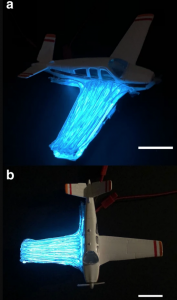 functionalities of both light-emitting and light-detecting within a single printed structure by printing them into an airplane wing, and capable of detecting a structural defect at any point within the wing. The printed airplane wing is seen to have light-emitters at the top and bottom layers, and, light-detectors in the bulk of the wing. As the light-emitters are operated, the photodetectors generate a photocurrent, with its magnitude corresponding to the length of the printed photodetectors filament. Upon the occurrence of a structural defect to the printed structure, the length is cut short, reducing the photocurrent. They can then detect the localized position of damage within the structure. In the paper, the authors describe how this capability is highly applicable for objects that are prone to collisions and high mechanical stresses such as 3D printed drones, prosthetics and parts of mobile vehicles, in which the lack of ability to uncover internal structural defects can lead to major failures.
functionalities of both light-emitting and light-detecting within a single printed structure by printing them into an airplane wing, and capable of detecting a structural defect at any point within the wing. The printed airplane wing is seen to have light-emitters at the top and bottom layers, and, light-detectors in the bulk of the wing. As the light-emitters are operated, the photodetectors generate a photocurrent, with its magnitude corresponding to the length of the printed photodetectors filament. Upon the occurrence of a structural defect to the printed structure, the length is cut short, reducing the photocurrent. They can then detect the localized position of damage within the structure. In the paper, the authors describe how this capability is highly applicable for objects that are prone to collisions and high mechanical stresses such as 3D printed drones, prosthetics and parts of mobile vehicles, in which the lack of ability to uncover internal structural defects can lead to major failures.
Moreover, one of the main advantages of the approach is the printing speed, which for this model structure wing took just 24 minutes, much faster than other 3D device fabrication methods. Also, the innovative team noted that the fabrication of such a highly-complex device wing shape can only be achieved through their volumetric freeform device-print approach because it allows for full shape customizability.
This ability to precisely customize each device is essential, and the method could potentially be developed further to produce a variety of different kinds of devices. Including biomedical, where matching the device to the patient’s own body can be important; such as in prosthetic limbs, using all the electronics to monitor and control the limb embedded in place. Additionally, this method might be a perfect fit to print materials for biomedical implants that would provide a scaffolding for the growth of new cells to replace a damaged organ, and include within it sensors to monitor the progress of that growth.
Over the years, the group has developed a wide array of fibers containing different materials and functionalities. Inspired by cucumber plants which use their tightly-coiled tendrils to pull the plants upwards, MIT researchers, including Fink, recently developed a new fiber-based system that could be used as artificial muscles for robots, prosthetic limbs, or other mechanical and biomedical applications. And just last year, they created a type of soft hardware that you can wear, that is, a cloth that has electronic devices built right into it. Fink even went on to create a smart thread that can send messages and change color.
MIT researchers’ idea to 3D print the multimaterial fiber ink in a printed model airplane wing was beyond original. When it comes to the aerospace field, a creation like this could make a big difference.
[Images: Felice Frankel and MIT]
The post MIT: A New Fiber Ink With Electronics Embedded Inside appeared first on 3DPrint.com | The Voice of 3D Printing / Additive Manufacturing.


